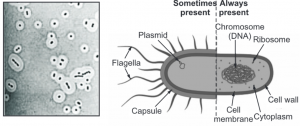Bacterial Capsule
- The bacterial capsule is a very large structure of many bacteria.
- It is a polysaccharide layer that lies outside the cell envelope and is thus considered as a part of the outer envelope of a bacterial cell.
- It is a well-organized layer and is the cause of various diseases.
- It is a 0.2 um thick viscous layer firmly attached to the cell wall of some capsulated bacteria.
- It is amorphous gelatinous covering surrounding cells.
- Usually, capsulated material is not highly water-soluble and doesn’t diffuse outside the cell but sometimes it is highly water-soluble and dissolves in the medium increasing viscosity of the broth.
- The capsule is found in both gram-negative and gram-positive bacteria. It is different from the second lipid membrane ie. bacterial outer membrane, which contains lipopolysaccharide and lipoproteins and is found only in gram-negative bacteria.
- The capsule is a very delicate structure. It can be removed by vigorous washing.
- The capsule is the most important virulence factor of bacteria.
- The capsule is visualized by the Negative staining technique.
- If it is thin and cannot be seen by light microscopy then it is known as a microcapsule
- If the capsule is too thick it is known as slime.
- Slime layers are loosely attached to the cell wall and can be lost on vigorous washing and subculture.
- Capsule and slime layer are sometimes summarized under the term glycocalyx.
- As a group where the capsule is present, they are known as polysaccharide encapsulated bacteria or encapsulated bacteria.

Composition of Capsule:
- 98% water and 2% polysaccharide or glycoprotein/ polypeptide or both.
- It contains usually homopolysaccharides which are synthesized outside the cell from disaccharides by extracellular enzymes. In case of Streptococcus mutans capsule contains glucan which is polymer of glucose made by using sucrose as a sugar source. In the case of Acetic acid bacteria, capsule is composed of homopolysaccharide (hemicellulose).
- Leuconostoc: Capsule is composed of cellulose, consisting of glucose or fructose.
- Other capsules are composed of heteropolysaccharides containing various sugars.
- Klebsiella pneumonia: Capsule is made up of glucose, galactose, rhamnose etc.
- In Bacillus anthracis, capsule is made up of Polypeptide (Polymer of D-glutamic acid) and in Streptococci, it is L-aminoacids.
- Bacillus megaterium synthesizes a capsule composed of polypeptide and polysaccharides.
- Streptococcus pyogenes synthesizes a hyaluronic acid capsule.
- Streptococcus agalactiae produces a polysaccharide capsule of nine antigenic types that all contain sialic acid.
Functions of Capsule:
- Prevent the cell from desiccation and drying: Capsular polysaccharide binds with a significant amount of water making cell resistant to dry.
- Protection: It protects from mechanical injury, temperature, drying, etc.
- Attachment: Capsule helps to adhere bacteria to smooth surfaces. E.g. Streptococcus mutans which cause dental carries attach on teeth surface by its capsule. Polysaccharide capsules potentially favour the attachment to surfaces and the formation of biofilms through non-specific forces such as electrostatic and van der Waals forces and/or specific ligand-receptor interactions.
- Anti-phagocyte: Capsule resists phagocytosis by macrophages.
- Capsule prevent attachment of bacteriophage on the cell surface making the cells resistant to bacteriophages
- Source of nutrition: Capsule is the source of nutrition when the nutrient supply is low in cells.
- Repulsion: If the capsule is made up of negatively charged compounds like sugar uronic acid they will repel other cells due to the same negative charge on the bacterial cell wall and thus avoid clumping or aggregation of cells.
- Increase virulence or pathogenicity: The capsule is considered a virulence factor because it enhances the ability of bacteria to cause the disease (e.g. prevents phagocytosis).
- The capsule can protect cells from engulfment by eukaryotic cells, such as macrophages.
Examples of Capsulated bacteria:
- Bacillus subtilis
- Bacillus anthracis
- Klebsiella pneumonia
- Haemophilus influenza
- Clostridium perfringens
- Neisseria meningitidis
- Pseudomonas aeruginosa
- Acinetobacter calcoaceticus
- Bacillus megaterium
- Streptococcus pyogenes
- Streptococcus pneumoniae (has at least 91 different capsular serotypes. These serotypes are the basis for the pneumococcal vaccines).
- Streptococcus agalactiae
- Staphylococcus epidermidis
- Staphylococcus aureus
- Escherichia coli
- Salmonella
References:
